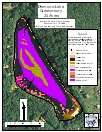Diamond Lake, Glastonbury - 2006
No vegetation management except for some localized hand pulling has been done and the lake supports abundant native vegetation that is generally not considered a nuisance. Shallow areas near the shore support sparse to moderate stands of watershield (Brasenia schreberi), sevenangle pipewort (Eriocaulon aquaticum), quillwort (Isoetes species), southern naiad (Najas guadalupensis), white water lily (Nymphaea odorata), and little floating heart (Nymphoides cordata). Deeper sections of the lake, comprising about two-thirds of the lake, support a luxuriant population of western waterweed (Elodea nuttallii) and sparse amounts of bladderwort (Utricularia species) and charaphyte (Chara). Moderately dense stands of small pondweed (Potamogeton pusillus) occur in the lakes center.
| Species recorded in our 2006 survey of Diamond Lake. Scientific Names |
|
| Bladderwort | Small pondweed |
| Charaphyte | Southern naiad |
| Little floating heart | Watershield |
| Quillwort | Western waterweed |
| Sevenangle pipewort | White water lily |
Other Diamond Lake Surveys: 2020


